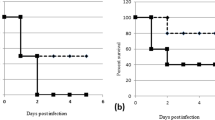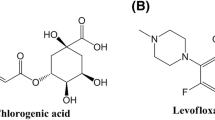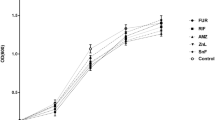Abstract
The problematic treatment of infections caused by multiple-resistant Klebsiella, especially in ICU, is the leading cause of prolonged hospitalization and high mortality rates. The use of antibiotics for the prevention of infections is considered unreasonable as it may contribute to the selection of resistant bacteria. In this regard, the development of drugs that will be effective in preventing infection during various invasive procedures is extremely necessary. We have shown that the developed innovative antibacterial compound fluorothiazinone (FT) that suppresses the formation of biofilms is effective in the prevention of a model pneumonia caused by a multi-resistant clinical K. pneumoniae isolate. Prophylactic use followed by treatment with FT in mice with acute pneumonia modulates the local innate immune response without suppressing protective properties in the early stages of infection, while contributing to a decrease in the bacterial load in the organs and preventing lethal pathological changes in the lungs at later stages of K. pneumoniae infection. Further development of such antivirulence drugs and their use will reduce morbidity and mortality in nosocomial infections, as well as reduce the number of antibiotics used.
This is a preview of subscription content, access via your institution
Access options
Subscribe to this journal
Receive 12 print issues and online access
$259.00 per year
only $21.58 per issue
Buy this article
- Purchase on Springer Link
- Instant access to full article PDF
Prices may be subject to local taxes which are calculated during checkout





Similar content being viewed by others
References
Ramadan RA et al. Carbapenem-resistant Klebsiella pneumoniae among patients with ventilator-associated pneumonia: evaluation of antibiotic combinations and susceptibility to new antibiotics. Infect Drug Resist. 2022. 3537–48. https://doi.org/10.2147/IDR.S371248.
Guo S, et al. Clinical and molecular characteristics of Klebsiella pneumoniae ventilator-associated pneumonia in mainland China. BMC Infect Dis. 2016;16:1–7. https://doi.org/10.1186/s12879-016-1942-z.
Martyanov AA, et al. Longitudinal multiparametric characterization of platelet dysfunction in COVID-19: Effects of disease severity, anticoagulation therapy and inflammatory status. Thrombosis Res. 2022;211:27–37. https://doi.org/10.1016/j.thromres.2022.01.013.
Liu C, Guo J. Characteristics of ventilator-associated pneumonia due to hypervirulent Klebsiella pneumoniae genotype in genetic background for the elderly in two tertiary hospitals in China. Antimicrobial Resist Infect Control. 2018;7:1–8. https://doi.org/10.1186/s13756-018-0371-8.
Martin MJ et al. A panel of diverse Klebsiella pneumoniae clinical isolates for research and development. bioRxiv. 2022. https://doi.org/10.1101/2022.08.17.504361.
World Health Organization et al. 2021 antibacterial agents in clinical and preclinical development: an overview and analysis. 2022.
Filimonova EV Davydova LA, Lysenko MA, Tsarenko SV Interstitial inflammation and pulmonary fibrosis in COVID-19: The potential role of cytostatic therapy for severe lung injury. Respir Med Case Reports. 2022. 101676. https://doi.org/10.1016/j.rmcr.2022.101676.
Surovoy YA, Burkin MA, Galvidis IA, Bochkov PO, Oganesyan AV, Tsarenko SV. Comparative polymyxin B pharmacokinetics in patients receiving extracorporeal membrane oxygenation. J Antimicrobial Chemother. 2022;77:1379–84. https://doi.org/10.1093/jac/dkac021.
Merritt JH, Kadouri DE, O’Toole GA. Growing and analyzing static biofilms. Curr Protoc Microbiol. 2011;22:С. 1B. 1.1–1B. 1.18. https://doi.org/10.1002/9780471729259.mc01b01s22.
Ito S, Karnovsky MJ. Formaldehyde-glutaraldehyde fixatives containing trinitro compounds. J Cell Biol. 1968;39:168A–169A. Part 2
Bondareva NE, Soloveva AV, Sheremet AB, et al. Preventative treatment with Fluorothiazinon suppressed Acinetobacter baumannii-associated septicemia in mice. J Antibiot. 2022;75:155–63. https://doi.org/10.1038/s41429-022-00504-y.
Sheremet AB et al. Small molecule inhibitor of type three secretion system belonging to a class 2, 4-disubstituted-4H-[1, 3, 4]-thiadiazine-5-ones improves survival and decreases bacterial loads in an airway Pseudomonas aeruginosa infection in mice. BioMed Res Int. 2018. 2018. https://doi.org/10.1155/2018/5810767.
Koroleva EA et al. Small molecule inhibitor of type three secretion suppresses acute and chronic Chlamydia trachomatis infection in a novel urogenital Chlamydia model. BioMed Res Int. 2015. 2015. https://doi.org/10.1155/2015/484853.
Nesterenko LN, et al. A small-molecule compound belonging to a class of 2, 4-disubstituted 1, 3, 4-thiadiazine-5-ones suppresses Salmonella infection in vivo. J Antibiot. 2016;69:422–7. https://doi.org/10.1038/ja.2015.131.
Zigangirova NA, et al. Development of Chlamydial type III secretion system inhibitors for suppression of acute and chronic forms of Chlamydial infection. Acta Nat. 2012;4:87–97.
Zigangirova NA, et al. Fluorothiazinon, a small-molecular inhibitor of T3SS, suppresses Salmonella oral infection in mice. J Antibiot. 2021;74:244–54. https://doi.org/10.1038/s41429-020-00396-w.
Kumar V, Chhibber S. Acute lung inflammation in Klebsiella pneumoniae B5055-induced pneumonia and sepsis in BALB/c mice: a comparative study. Inflammation. 2011;34:452–62. https://doi.org/10.1007/s10753-010-9253-9.
McDaniel DK, Allen IC Using Klebsiella pneumoniae to model acute lung inflammation in mice. Mouse Models of Innate Immunity. Humana Press, New York, NY, 2019. P. 169-80. https://doi.org/10.1007/978-1-4939-9167-9_15.
Vijay K. Pulmonary innate immune response determines the outcome of inflammation during pneumonia and sepsis-associated acute lung injury. Front Immunol. 2020;11:1722 https://doi.org/10.3389/fimmu.2020.01722.
Meijer MT, et al. Tenascin-C deficiency is associated with reduced bacterial outgrowth during Klebsiella pneumoniae-evoked pneumosepsis in mice. Front Immunol. 2021;12:С. 600979 https://doi.org/10.3389/fimmu.2021.600979.
Rukavina T, Vasiljev V, Ticac B. Proinflammatory cytokines in antilipopolysaccharide immunity against Klebsiella infections. Med Inflamm. 2005;2005:88–95. https://doi.org/10.1155/MI.2005.88.
Zigangirova NA, et al. Antibacterial agents reducing the risk of resistance development. CMAC J. 2021;23:184–94.
Author information
Authors and Affiliations
Corresponding author
Ethics declarations
Conflict of interest
The authors declare no competing interests.
Additional information
Publisher’s note Springer Nature remains neutral with regard to jurisdictional claims in published maps and institutional affiliations.
Rights and permissions
Springer Nature or its licensor (e.g. a society or other partner) holds exclusive rights to this article under a publishing agreement with the author(s) or other rightsholder(s); author self-archiving of the accepted manuscript version of this article is solely governed by the terms of such publishing agreement and applicable law.
About this article
Cite this article
Tsarenko, S.V., Zigangirova, N.A., Soloveva, A.V. et al. A novel antivirulent compound fluorothiazinone inhibits Klebsiella pneumoniae biofilm in vitro and suppresses model pneumonia. J Antibiot 76, 397–405 (2023). https://doi.org/10.1038/s41429-023-00621-2
Received:
Revised:
Accepted:
Published:
Issue Date:
DOI: https://doi.org/10.1038/s41429-023-00621-2
This article is cited by
-
Pharmacokinetics, tissue distribution, bioavailability and excretion of the anti-virulence drug Fluorothiazinon in rats and rabbits
The Journal of Antibiotics (2024)



